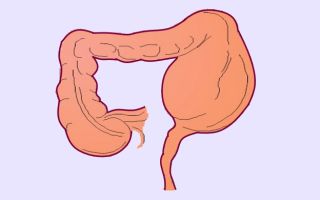Hirschsprung's disease is a congenital injury to the intramural nerve plexuses of the intestine with the presence of a zone of narrowing in the distal colon with simultaneous expansion and elongation of the overlying sections (congenital megacolon).
Description of the disease
The disease was first described by the German pediatrician Hirschsprung. It occurs with a frequency of 1:5000 births and is more often observed in boys.
In the development of the disease, the main role is played by heredity or intrauterine developmental disorders of the neuromuscular and submucosal plexuses. As a result, the intestine cannot relax properly.
In 90% of patients, tension is detected in the zone of transition of the sigmoid colon to the rectum or in the final section of the sigmoid colon. In these sections there is no peristalsis, the muscle fibers are in a contracted state. Usually the internal anal sphincter is also affected, which is unable to relax.
Normally, when the rectum is filled with feces, it stretches and the sphincter relaxes, but with Hirschsprung's disease, irritation of the wall of the affected area of the intestine causes it to contract.
Symptoms
- The main symptom is the absence of stool from an early age.
- Stool is caused by cleansing enemas.
- Abdominal pain is characteristic.
- Persistent bloating of the abdomen leads to its enlargement and it takes on the appearance of a frog.
- Peristaltic contractions of the intestine can often be seen.
- Fecal stones often form in the colon.
As chronic obstruction develops,
- headache,
- nausea,
- dyspnea.
In about half of patients, bowel function may temporarily improve with age, but then decompensation occurs again. Stagnation of feces appears and acute intestinal obstruction may develop.
Diagnostics
The main method to establish the diagnosis is an X-ray examination of the colon using a barium enema.
The following picture is typical:
- the rectum has the shape of a cylinder,
- the distal part of the sigmoid colon is narrowed,
- colon and is sharply expanded above the constriction, which has a cone shape.
The degree of impairment of motor-evacuation function can be judged by studying the passage of barium sulfate or radiopaque capsules through the gastrointestinal tract. The contrast mass lingers in the dilated parts of the colon above the narrowed area for up to 4-5 days.
During sigmoidoscopy, attention is paid to the empty rectum even with preparation for the study. The distal part of the rectum is narrowed, the folds are thickened. The middle part, on the contrary, is expanded and contains feces or fecal stones.
A conventional mucosal biopsy has no diagnostic value. To clarify the diagnosis, a section of the intestinal wall with its muscular layer is excised. The absence or decrease in the number of ganglion cells in the tissue examined confirms Hirschsprung's disease.
Another hallmark of the disease is the absence of the rectoanal reflex. In patients with acquired forms of megacolon, this reflex is not impaired.
It is necessary to carry out a differential diagnosis with Chagas syndrome, idiopathic megacolon and other diseases accompanied by constipation.
Chagas syndrome
This is a pathological expansion of hollow organs, including the colon, caused by the destruction of nerve ganglion cells.
The syndrome develops as a late consequence of an acute form of American trypanosomiasis .
In this case, the central nervous system, myocardium, and gastrointestinal tract are affected. The reason for the expansion of the colon is tension in the anal sphincter due to damage to the nerve ganglia.
Treatment
Treatment in infancy is limited to cleansing enemas. Subsequently, surgery is indicated for Hirschsprung's disease. The main goal of surgical treatment is to remove the affected area and decompensated dilated parts of the colon.
Forecast
The prognosis for Hirschsprung's disease depends on the timeliness and quality of surgical treatment.







